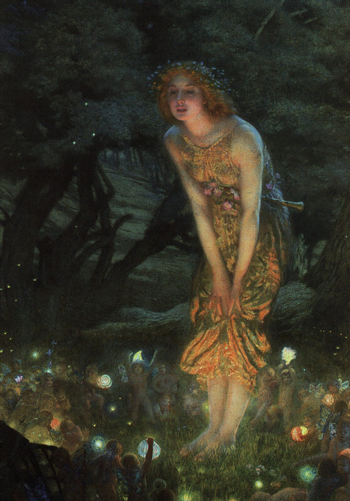| Search Art Prints | ||||||||||||||||||||
| Search Artists | ||||||||||||||||||||

|
||||||||||||||||||||
|
|
|||||||||||||||||||

Midsummer Eve

|
Edward Robert Hughes began his career among the Pre-Raphaelite painters. His art reflected Symbolism and the majority of his paintings were watercolors. He was a painstaking perfectionist and did many meticulous preliminary preparatory studies before he began his actual painting.
Much of Hughes’s work was based on Shakespearean themes. Midsummer Eve is reminiscent of A Midsummer Night’s Dream, Shakespeare’s play about the miss matching of lovers on a magical midsummer’s evening. In this play the fairy Puck utters, ‘Lord what fools these mortals be’. Looking at the painting, one can almost imagine the tiny fairies saying such things to the girl who could easily be Hermia, one of the poor unfortunate lovers who get lost in the forest, awakening from a dream only to discover herself in a ring of fairies dancing about her. There is a strong sense of magic about the painting. But, in a strange way, it is almost as if the girl had expected to see the fairies or at least, she is not surprised by their presence. She seems eager to know what they are saying while bending towards them to get a better look. Certainly, she is not frightened. Judging from the way she is dressed, she has perhaps even been yearning for them to appear. Traditionally, Midsummer’s Eve is a night when young girls dance around fires and make wishes for their true loves to come to them. It is a magical spell-casting night. Furthermore, it is the shortest night of the year and the lighting of the painting suggests that although it is not dark, it is late in the evening.











